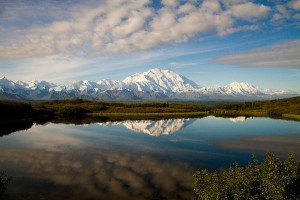
A dispute over the height of North America’s tallest mountain may be resolved this week, as surveyors climb to the top of Mount McKinley.
McKinley – recognized throughout Alaska by its Koyukon Athabascan name, Denali – has long been thought to stand at 20,320 feet, a measurement recorded in 1953. That number was contested in 2013, when the United States Geological Survey (USGS) used radar technology to re-calculate the mountain’s height. The result was a mere 20,237 feet… 83 feet lower than the previously recognized elevation.
“Oh, people didn’t like the lower number. And I was bothered by it myself. I mean I had people say, ‘It’s still over 20,000 feet, I hope?’ And I said, ‘Yes it’s still over 20,000 feet, but I don’t know how much over 20,000 feet.’”
Dave Moune is senior project manager with Dewberry Geospacial Products and Services – a company contracted by USGS to perform the 2013 survey. Moune says the “new” elevation, in addition to being controversial, may not be entirely accurate.
He says the measurement was taken from the air using radar frequencies, to create 3D images as part of an ongoing mapping project around the state. And while that technique is great for mapping complex terrain in 3D, Moune says its single-point elevation measurements could be off by several meters.
He adds the most accurate way to measure height for a specific peak is to use GPS. But for that, you need old-fashioned boots on the ground…
“Hey there, this is Blaine. We’re up at 14,000 feet on Denali on the summit survey expedition.”
Blaine Horden is leading those boots – and a team of three surveyors – to the summit of Denali this week. Their mission: To set the record straight.
As of Monday night, the team had settled in at 14,000 feet… with plans to push for the summit as early as Wednesday. But Moune says the task of measuring a mountain isn’t an easy one.
“These guys are not just taking themselves to the top of the mountain. They are carrying a lot of equipment with them. That all has weight associated with it. Some of it is stuff they have to keep inside their coat so their bodies will help keep it warmer. That all adds to the complexity of the climb.”
In addition to challenges faced by all high-altitude climbers, the team will need to clear a few logistical hurdles. For example: finding the physical peak of Denali – rock that has been buried under feet of ice and snow.
This is an ambitious goal. No survey of the mountain so far has calculated elevation using its natural peak… all measurements have been taken from ice resting on *top* of the mountain. Which, Moune says, could have contributed to some level of error in the past.
“People want to know how high is Denali. And perhaps the best we can do is tell them how high the ice and snow is in 2015 on the day that we surveyed it. Recognizing that the thickness of the ice and snow may change whenever it snows and rains up there. Or melts for that matter.”*
Moune says even if Horden’s team also measures from the ice at Denali’s summit, the data they gather will still provide an improved estimate of the mountain’s true height.
The expedition could take as long as three weeks to complete, but Moune reports that the surveyors are currently ahead of schedule – and could begin their descent by the end of this week.
And the height of the continent’s tallest mountain isn’t the only thing up for debate. The name of the famous Alaskan peak has long been a point of contention – both in, and out, of state.
Alaskans have filed several federal bills since 1975 to change the name from Mount McKinley – after former president William McKinley – to Denali, a traditional Koyukon Athabascan term meaning “high one” or “great one.”
That effort has been largely opposed by representatives from McKinley’s home state of Ohio – with Rep. Bob Gibbs filing a bill that would stop theU.S. board of Geographic Names from changing the mountain’s title as recently as March 2015.
Last month, Sen. Lisa Murkowski introduced yet another bill to change the name to Denali in honor of the region’s Native heritage. It remains unclear whether either legislator will succeed in pushing their bill through the House or the Senate.
Francesca is a reporter at KNOM in Nome.




